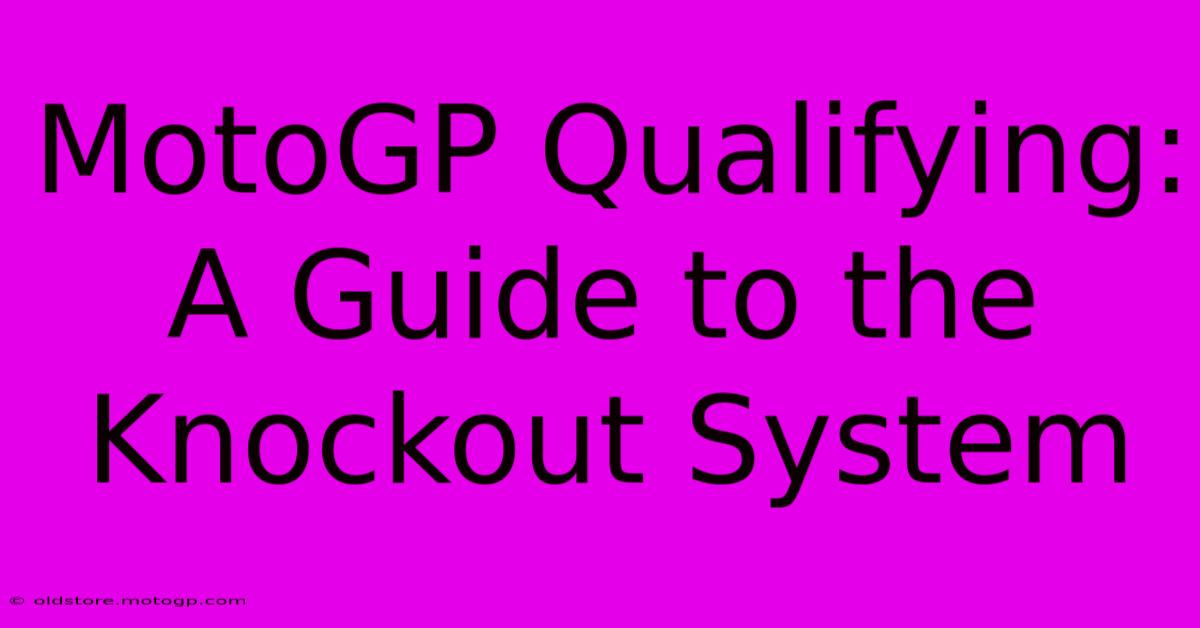MotoGP Qualifying: A Guide To The Knockout System

Table of Contents
MotoGP Qualifying: A Guide to the Knockout System
MotoGP racing is a thrilling spectacle of speed, skill, and strategy. But before the lights go out on race day, the all-important qualifying sessions determine the starting grid. Understanding the intricacies of MotoGP qualifying is crucial for any fan hoping to fully appreciate the drama and the strategic nuances at play. This guide breaks down the knockout system, explaining how riders fight for pole position.
The Anatomy of MotoGP Qualifying: A Knockout Format
MotoGP qualifying utilizes a knockout system, often referred to as a "Q" system. This dynamic format adds layers of excitement and high-stakes competition, separating the wheat from the chaff in a dramatic display of speed. The process unfolds across three stages:
Q1: The First Cut
- Participants: The 10 slowest riders from the combined Free Practice (FP) sessions 1, 2 and 3 automatically start in Q1. This means the riders who didn't set a fast enough lap time in the practice sessions are battling it out to advance.
- Objective: The top two fastest riders from Q1 progress to Q2. This session is intense, with every rider pushing their machine and their skills to the limit. The pressure is high, as a small mistake can mean the difference between moving on and starting further back on the grid.
- Duration: A limited time frame adds to the pressure cooker atmosphere. Riders have only a small window to achieve the best possible lap times.
Q2: The Final Showdown
- Participants: The top 10 riders from the combined Free Practice sessions automatically qualify for Q2, joining the two qualifiers from Q1. This ensures the fastest riders from the weekend's practice sessions are competing for the coveted pole position.
- Objective: The objective is simple: secure the fastest lap time. This determines the starting position for the race, with pole position offering a significant advantage. The fight for the front row (positions 1-3) is fierce and often decided by hundredths, or even thousandths, of a second.
- Duration: Like Q1, time is of the essence in Q2. Riders have a limited window to set their fastest lap. The tension is palpable as the clock ticks down, and the competition pushes the boundaries of speed and control.
Understanding the Importance of Qualifying
The starting grid in MotoGP is incredibly important. A good qualifying performance can significantly influence the race outcome:
- Track Position: Starting at the front grants riders a crucial advantage, allowing them to control the race pace and avoid getting stuck in traffic.
- Race Strategy: A front-row start allows riders to implement their race strategy more effectively.
- Psychological Advantage: Securing pole position provides a significant psychological boost, setting the tone for the race.
Factors Influencing Qualifying Performance
Several factors come into play during qualifying:
- Bike Setup: A finely tuned motorcycle is crucial for maximizing performance. Engineers work tirelessly to optimize the bike's setup for qualifying, often making adjustments between practice and qualifying.
- Tire Choice: Selecting the right tires is critical. The choice will depend on track conditions, temperature, and the rider's preference.
- Weather Conditions: Changing weather conditions can dramatically alter track grip and lap times, requiring riders to adapt quickly.
- Rider Skill and Fitness: A rider's skill, fitness, and focus are paramount. The pressure is intense, and a rider's ability to remain calm and focused under immense pressure is crucial.
Conclusion: More Than Just a Warm-up
MotoGP qualifying is far more than a mere warm-up before the race. It's a high-octane, nail-biting spectacle in its own right, determining the starting grid and setting the stage for the main event. By understanding the knockout system and the factors at play, fans can gain a deeper appreciation of the drama and the strategic battles unfolding on track. The race for pole is often as exciting as the race itself!

Thank you for visiting our website wich cover about MotoGP Qualifying: A Guide To The Knockout System. We hope the information provided has been useful to you. Feel free to contact us if you have any questions or need further assistance. See you next time and dont miss to bookmark.
Featured Posts
-
F1 Us Grand Prix Tv Coverage Get Closer To The Action
Feb 19, 2025
-
Cota Motorcycle Track Days Ride With Confidence
Feb 19, 2025
-
Moto Gp Sprint Race The Results Are Finally Here
Feb 19, 2025
-
The Evolution Of Moto2 Bikes From Humble Beginnings To Global Phenomenon
Feb 19, 2025
-
Desmosedici The Moto Gp Machine With A Winning Pedigree
Feb 19, 2025
